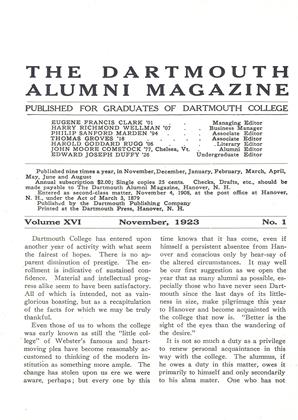"Industrial Organization. An Intriduction to the study of Economics"
November 1923 JAMES G. STEVENSpp 421. By Malcolm Keir. The Ronald Press Company. 1923.
"The purpose of this book is to supply the background of facts about our industrial organization, so that any subsequent delving into economics may be more vivid and real — to present a picture in perspective of the interlocking factors that make up our national industrial life." (Preface).
In the pursuit of this stated purpose the author deals, in the order given, with the occupations of agriculture, mining, forestry, the manufacturing industries, marketing, transportation, foreign trade, labor problems, money, credit, and banking, forms of business organization, and the relation of the state to industrial enterprise.
The author has presented excellent factual material throughout the book. In every chapter there is a wealth of fact about our economic society which every beginning student needs if he is to understand, even in an elementary way, the processes of industry and exchange and the relation of the individual and the group to them. To any one needing an abundance of detail regarding economic life this work will be most useful.
In attempting to introduce the subject of economics to the student there are always questions which develop pronounced disagreement among the economists themselves. One is the problem of proportion, the amount of material to be devoted to each phase of the field. For example, the author has devoted about twenty pages to agricultural economics. Some economists would say that this was not enough for such an important problem. About thirty pages are devoted to labor and its problems. There would be sharp disagreement among the economists in regard to the amount of time and space necessary to explain this phase of industry. These examples are given to indicate the nature of the problem involved in selecting material in a proportionate way, not as a specific criticism of the description of these mentioned phases of economic society.
Just as important as the problem of proportion is the question of how much fact shall be presented to the beginning student without a substantial explanation of the functional processes of all those facts in the entire industrial scheme. For example, shall the subject of railroads be treated as a structural description of the services rendered without considerable description and explanation of the problems arising from the relation of transportation to agriculture ? Shall the railroad organization be described as a condition of industrial anatomy without explaining in some detail the intimate relation between the bankers and the railroad leaders, and the problems arising from this relationship? Shall the description of organized labor be confined to an explanation of unions and the weapons they employ in industrial conflicts without substantial detail about the distribution of income and the psychological results of the facts of income distribution? The author places himself in the group which puts the emphasis upon fact with relatively little explanation and touches lightly the economic theories involved. To those who agree with this point of view and method the book will be useful. It will be less serviceable to the economists who insist upon the intimate correlation between facts and the economic relationships and theories which explain the facts as a part of the entire scheme of industrial organization. Economists differ in the matter of approach to an introductory study of economics. More actual testing of these different methods in teaching practice is needed to determine which method is more desirable for the beginning student.
There has recently been issued an attractively printed and well illustrated pamphlet "Dedication of the First Meeting-House Monumentin Old Bennington." This pamphlet contains an address delivered on July 8, 1923, by Prof. Lewis D. Stilwell, entitled "Bennington's Part in Vermont Independence."
Charles Scribner's & Sons has published "Race and National Solidarity" by Prof. Charles Conant Josey, formerly Assistant Professor of Psychology of Dartmouth.
Recent publications by Prof. W. H. Wood are: "Types of Religious Thinking," published in the May 10 issue of the Christian Advocate; "Fundamentalism, Its Rise and Progress," published in the May issue of ChristianEducation; "Worker's Education Movement inGreat Britain," published in the New YorkChristian Advocate.
Prof. W. M. Urban is the author of an article "Origin and Value," published in the September issue of the Philosophical Review.
"Hints for European Travellers" by Prof. George Breed Zug was published this last summer as a little pamphlet of 22 pages.
The 9th Biennial Report of the N. H. State Highway Department 1921-22 contains the report of the State Highway Geologist, Prof. J. W. Goldthwait.
 View Full Issue
View Full Issue
More From This Issue
-
 Article
ArticleTHE GOAL OF EDUCATION
November 1923 By ERNEST MARTIN HOPKINS -
 Article
ArticleDartmouth College has entered upon
November 1923 -
 Article
ArticleAFTER TEN YEARS
November 1923 By FRANK LATIMER JANEWAY -
 Class Notes
Class NotesCLASS OF 1910
November 1923 By Whitney H. Eastman -
 Class Notes
Class NotesCLASS OF 1903
November 1923 By Perley E. Whelden -
 Class Notes
Class NotesCLASS OF 1917
November 1923 By Ralph Sanborn
Books
-
 Books
BooksFaculty Publications
March 1934 -
 Books
BooksMASSACHUSETTS PRACTICE. VOLUME 28. CONVEYANCING WITH FORMS.
JUNE 1968 By DOUGLAS L. LEY '35 -
 Books
BooksA PECULIAR SERVICE.
MARCH 1966 By JERE R. DANIELL II '55 -
 Books
BooksMANY-COLORED BELGIUM
OCTOBER 1931 By Leon Verrriest -
 Books
BooksHOP ON POP.
APRIL 1963 By MAUDE D. FRENCH -
 Books
BooksAMERICAN PENMANSHIP
JULY 1970 By TRUMAN H. BRACKETT JR. '55


